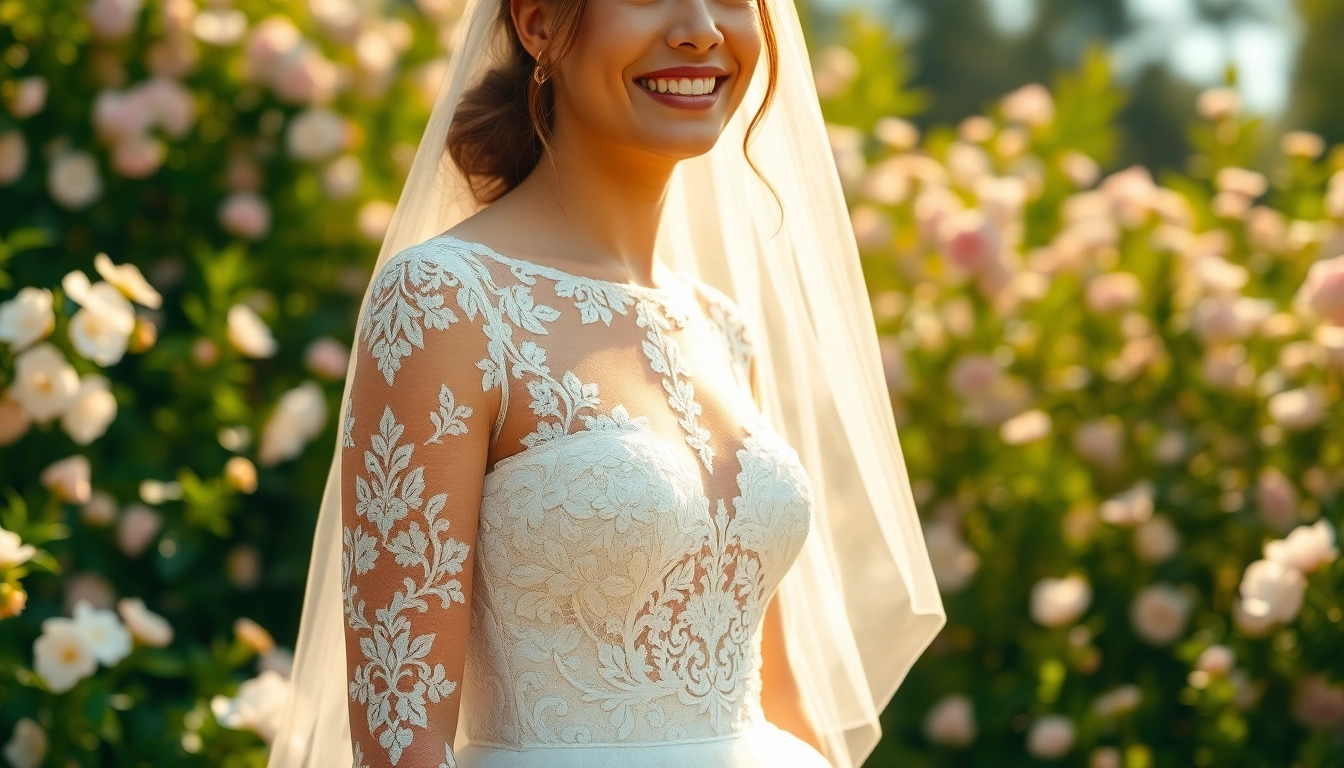Understanding Lace Wedding Dresses
What Are Lace Wedding Dresses?
Lace wedding dresses are the epitome of bridal elegance, combining intricate designs with delicacy and sophistication. Typically crafted from fine threads, lace adds a layer of visual allure through its open weave and decorative patterns. Whether the lace is floral, geometric, or abstract, each dress tells a story of romantic elegance and grace. These dresses come in multiple silhouettes, from enchanting ball gowns to figure-hugging mermaid styles, each showcasing the beauty of lace uniquely. Not merely a design choice, lace carries deep-seated symbolism—often representing femininity, purity, and tradition in bridal fashion. For brides looking for both style and sophistication, a Lace Wedding Dress is an exemplary choice that embodies timeless beauty.
History and Evolution of Lace in Bridal Fashion
The origins of lace date back to the 15th century, primarily in Europe, where its delicate craftsmanship quickly gained popularity among nobility. Initially, lace was hand-made from linen or silk threads, making it a luxurious item that only the wealthiest could afford. By the 19th century, lace had firmly established itself in bridal couture, with manufacturers beginning to create intricate lace patterns specifically for wedding gowns. The fabric symbolized wealth and social status, often being adorned on gowns to reflect the wearer’s refinement and style.
As the decades progressed, lace transitioned from being an exclusive luxury to a more accessible fabric, democratizing bridal fashion and widening its use in wedding dresses. Today, lace wedding dresses serve as a bridge between traditional elegance and modern interpretation, ensuring their place in contemporary bridal attire.
Types of Lace Used in Wedding Dresses
The variety of lace types available adds depth and dimension to lace wedding dresses. Some popular lace types include:
- Chantilly Lace: Known for its soft and fine texture, Chantilly lace is characterized by its floral patterns and delicate edges.
- Alençon Lace: This French lace features a raised design that combines floral motifs with intricate embroidery, offering a sumptuous look.
- Venise Lace: A heavier lace with a pronounced design, Venise lace is often used as an overlay or in appliqué, providing great structure to the dress.
- Net Lace: Often used for overlays, net lace has a more straightforward appearance, allowing for versatility in bridal wear.
- Corded Lace: Featuring a raised cord pattern, this lace type adds texture and dimension to wedding dresses, enhancing the visual appeal.
Each lace type brings its charm and character to wedding dresses, allowing brides to experiment with varying designs to match their personal style.
Choosing the Perfect Lace Wedding Dress
Consider Your Body Type and Style
Choosing the perfect lace wedding dress begins with understanding your body type and personal style. Lace dresses come in various silhouettes, and selecting one that enhances your natural shape is crucial. For example:
- A-Line Silhouettes: These dresses fit snugly at the waist and gradually flares out, making them flattering for almost every body type.
- Mermaid and Trumpet Styles: These form-fitting designs accentuate curves, ideal for brides with hourglass figures.
- Ball Gowns: Perfect for achieving a classic, fairy tale look, ball gowns have a fitted bodice and a voluminous skirt.
- Sheath Dresses: Sleek and flattering, these dresses follow the body’s natural curves, perfect for slender silhouettes.
Your style also plays a significant role in your choice. Are you drawn to romantic, vintage aesthetics, or do you prefer modern and minimalist designs? Keep in mind that lace can enhance various styles, seamlessly fitting into both bohemian and sophisticated themes.
Finding the Right Fit and Comfort
When selecting a lace wedding dress, the right fit and comfort level are essential. Here are some factors to consider:
- Try Before You Buy: Always try the dress on before making a purchase decision. Different designers may have varying sizing standards, so it’s crucial to find a size that suits you comfortably.
- Movement: Ensure you can move freely in the dress, especially if you plan to dance at your wedding. Raise your arms, sit down, and walk to ensure the dress allows for ease of movement.
- Support: Consider dresses with built-in support or boning for a structured fit. This is especially important for strapless designs.
Finding a balance between style and comfort can enhance your wedding experience, allowing you to shine with confidence as you walk down the aisle.
Balancing Lace with Other Fabrics
While lace is stunning on its own, combining it with other fabrics can create a unique and luxurious gown. Popular choices include:
- Silk: This lustrous fabric complements lace beautifully, adding a soft backing and structure to the dress.
- Tulle: Layering lace with tulle can give a dreamy, ethereal quality, perfect for whimsical brides.
- Crepe: Known for its stretchy and form-fitting qualities, crepe can balance delicate lace, providing a smooth silhouette.
Combining lace with these fabrics can elevate your dress, ensuring it is both striking and comfortable, as well as unique to your personal taste.
Trending Lace Wedding Dress Styles
Classic A-line and Ball Gown Designs
A-line and ball gown designs continue to dominate wedding fashion trends. These silhouettes are timeless, offering brides a classic yet elegant feel. A-line dresses, with their narrow bodice flowing into a gentle skirt, are flattering for all body types. Meanwhile, ball gowns amplify the fairy tale fantasy, with voluminous skirts sourced from layers of tulle, satin, or organza complemented by delicate lace detailing.
Brides are embracing traditional white or ivory dresses with subtle embellishments, such as beaded lace or embroidered overlays, adding a personal touch to their classic bridal look.
Modern and Minimalist Approaches
On the other end of the spectrum, modern and minimalist lace wedding dresses are gaining popularity. These gowns often feature clean lines, sleek silhouettes, and minimal embellishments, providing a chic and sophisticated look. The integration of lace in sharp necklines or as billowing sleeves can elevate simplicity to a new level of elegance.
Brides opting for this style benefit from versatility, as minimalist designs seamlessly transition from ceremony to reception, allowing ease of movement and the freedom to enjoy their special day.
Bohemian and Vintage Lace Inspirations
For the free-spirited bride, bohemian bridal designs continue to be a sought-after trend. These dresses often feature flowing fabrics, lace overlays, and earthy colors that capture the essence of nature. Vintage lace styles, such as those from the 1920s or 1970s, often integrate artistic floral motifs and intricate hem details, creating a romantic vibe.
Incorporating vintage elements into modern designs, brides can choose lace appliqués and patterns that harken back to older eras while still providing a contemporary fit and style.
Accessorizing Your Lace Wedding Dress
Complementary Veils and Headpieces
The right veil or headpiece can enhance your lace wedding dress, adding depth and style to your overall look. When selecting, consider:
- Length: A floor-length veil creates a dramatic effect, while a shorter veil may be more suitable for modern bridal looks.
- Materials: Look for veils that feature lace trim or patterns echoing that of your dress.
- Hair Accessories: Hairpieces adorned with pearls or floral accents can blend beautifully with lace designs.
By thoughtfully pairing your lace dress with a veil or headpiece, you can complete a cohesive and radiant bridal look.
Jewelry and Footwear Tips
When it comes to jewelry and footwear, less can often be more. Consider these guidelines:
- Jewelry: Select pieces that complement, rather than compete with, the intricate lace of your dress. Simple stud earrings or a delicate bracelet can enhance your look without overshadowing it.
- Footwear: Classic pumps or stylish sandals can add elegance. If your gown has intricate lacework, opt for nude or metallic tones that harmonize with your overall color scheme.
Choosing the right accessories elevates your wedding ensemble while ensuring that the focus remains on your captivating lace dress.
Choosing the Right Bouquet
Your bouquet plays a pivotal role in your wedding aesthetic. When pairing flowers with your lace wedding dress, consider:
- Colors: Choose floral arrangements that complement the colors of your dress. Soft pastels or rich jewel tones can create stunning contrasts.
- Styles: Lush, romantic bouquets can enhance the softness of lace, while structured arrangements may suit minimalist styles better.
- Size: Be mindful of bouquet size; it should be proportional to your dress and height to avoid overshadowing any gowns with intricate details.
The right bouquet can enhance your bridal ensemble, adding the final flourish to your lace wedding dress.
Caring for Your Lace Wedding Dress
Cleaning and Preservation Techniques
After your wedding day, proper care for your lace wedding dress is vital to ensuring its longevity. Here are crucial steps to consider:
- Spot Cleaning: Immediately address spills or stains with a gentle, damp cloth. Avoid rubbing, as this may damage the lace.
- Professional Cleaning: Seek specialized bridal gown cleaning services that understand how to handle delicate fabrics and lace.
Investing in professional cleaning ensures that intricate lace details remain intact while restoring the dress to its original beauty.
Storing Your Dress After the Big Day
Once cleaned, the right storage method is vital in maintaining the pristine condition of your lace wedding dress:
- Cool, Dry Place: Store your dress in a climate-controlled area, away from direct sunlight, which can lead to fading.
- Acid-Free Garment Bag: Use a breathable, acid-free garment bag to protect your dress from dust while allowing moisture to escape.
Following these storage techniques can preserve the delicate lace and fabric, ensuring the dress remains a treasured keepsake.
Restoring Lace for Future Use
If you plan on wearing your lace dress again, restoration may be necessary. Here’s how to go about it:
- Assessing Damage: Check for tears, discoloration, or other wear and tear, and address these concerns promptly.
- Consult a Professional: A trained seamstress familiar with lace can carefully make repairs without compromising the gown’s integrity.
Restoring your lace wedding dress can breathe new life into it, allowing you to wear it again on special anniversaries or events.

